THIS PAGE & MY ENTIRE FAMILY HISTORY DOMAIN IS PROTECTED BY AWARD WINNING "SITELOCK SECURE".
I PAY A MONTHLY FEE FOR THIS PROTECTION versus a SSL CERTIFICATE.
ANDREW J. "JACK" GAYLOR (1849-1921)
(Jack married #2: Margaret Rutledge 4 Nov 1890 Lander, Fremont Co WY//Divorced)
(Links to the children of Jack & Sallie are at the bottom of this page)
Andrew Jackson "Jack" Gaylor was born 7 January 1846/49, (probably 1849) near Granville in southern Jackson County, Tennessee & was the son of Jack's father, John Jr, was born 1822 in Tennessee soon after his parents left
Georgia. His parents then settled in Franklin County, Illinois during the 1820's, however, returned to
Tennessee during the late 1830's before settling in NE Alabama/NW Georgia where
relatives still resided. It is also believed that Jack's father, after reaching adulthood,
moved back to middle Tennessee during the 1840's where his future wife Martha Ann Simpson
resided.
Jack's mother Martha was born 11 February 1827, probably in Ohio, but as a child
resided near McMinnville, Warren County, TN. Martha's parents were William &
Matilda (Rowland) Simpson who were from Shenandoah County, VA. William & Matilda
Simpson left Virginia during the 1820's & probably resided briefly in Ohio before
eventually settling in Tennessee by 1830.
Martha married John Gaylor about 1844, probably near McMinnville in Warren County, TN where they met during that decade.
Jack's sister, Sarah Matilda, was born 1846/1847 & was evidently named after her paternal & maternal grandmothers. During
the 1850 census, John & Martha Gaylor were residing near Granville in southern Jackson County, Tennessee.
It is believed Martha's father, William Simpson, died during the 1840's near McMinnville, TN & her mother Matilda
resided with the Gaylor family when they moved north to Jackson County, TN. Martha's
brother William Rowland Simpson, born 1831, was residing next door with his young
bride Eliza, daughter of Robert Biggs.
Jack's youngest brother, John Thomas "Tom" Gaylor, was born 1851 in Marion County, Tennessee, not too far from the Alabama/Georgia border where father John's relatives resided. Not much else is known about their father John Gaylor, but he either died in Tennessee about 1853 or after they began their long arduous trip to the Ozarks of southwestern Missouri. Martha's older sister Roseanna had already settled in that area of Missouri with her husband Rev Joel F. Mitchell about a decade earlier.
While in Barry County, Jack's mother Martha married widower William Brummett in September 1854. The marriage ceremony was performed by Martha's brother-in-law, Rev Joel F. Mitchell, a local Baptist minister/farmer. They resided in Sugar Creek
Township, in an area known as Roller's Ridge of the Washburn Prairie which was situated about 2 miles northwest of what is now the small town of Seligman, near the Arkansas line. Their close neighbors, other than Martha's sister Roseanna, were Montgomery
Hamilton, the King & Harbin families, & other families who were all pioneer settlers of that area. Widow Nancy Pallett and her family had settled there from Cass County MO during the 1850's. Her son Richard Pallett married Roseanna (Simpson) Mitchell's daughter Martha Jane.
William Brummett was an older man, born about 1811, whose first wife Nancy Ray died around 1854. William had several children from his previous marriage to Nancy Ray. They were Elizabeth, Mary Jane, Narcissa, Martha, William, Johnson & John
Brummett. Mr Brummett became the step-father of the Gaylor children. The turmoil of pre-civil war years was gradually increasing in this area of Missouri, Arkansas, & nearby Kansas during the mid 1850's. The Gaylor & Brummett families were not slave owners,
or large land owners, just simple, hard working farmers, who struggled to make a living during their journeys throughout the south. Their neighbors on the Washburn Prairie, were mostly slave owners & established land owners, also from the south, but there were
also many northerners who had settled all around them. Most of these settlers who were from diverse backgrounds of various areas of the country, both north and south, were good, descent people. However the emotional issues of the day were about to get out of
control with political extremists & local "bushwhackers" from both groups leading the nation to the eventual Civil War. Martha's brother-in-law Rev Joel F. Mitchell, a Confederate sympathizer, was killed by Federal bushwhackers during the war.
The Gaylor & Brummett families, also believed to be southern sympathizers, evidently decided that it was time to settle in a safer area where there were fewer northern influences & partisan conflicts between pro and anti slavery or other states rights issues. William Brummett's brother and other relatives had settled in northeast Texas about a decade earlier. William decided to move the family to this area around 1858. It is quite likely that the family traveled in a group of other settlers by wagon train entering northwest Arkansas along the old Osage Trail into Fayetteville. Here in Fayetteville, they may have completed the outfitting of their wagons with certain provisions they couldn't find in Barry County.
They most likely headed west into Indian Territory and eventually made it to theTexas Trail, near Fort Gibson and the 3 forks area of the Cherokee Nation. Most early settlers again stocked up and rested as necessary at Fort Gibson after this 2d phase of the trip to Texas. They headed south along this Texas Trail, which was another major frontier turnpike for freighters and settlers traveling through the Cherokee & Choctaw Nations of Indian Territory. The final phase of this long journey would be crossing the Red River and entering northeast Texas. This road crossed the Red River into Texas at Colbert's Ferry, just northwest of the area in Fannin County, TX where they settled. The Gaylor/Brummett family settled a few miles northwest of Ladonia, Fannin County, Texas.
From "Historical Atlas of Oklahoma" is the following:
"The Texas Road developed as a natural result of travel from the north and east into the
Indian country and later from the demand for a route to the Mexican province of Texas.
The flood of travelers along this route made it the most important artery of commerce
between the settlements of Missouri and Kansas, at one end, and the Red River, at the
other. Immigrants who came in from Arkansas reached the Texas Road at Three Forks or
farther south. Salina, North Fork Town, Boggy Depot and many other towns felt the
impact of trade incidental to the Texas migration and the return of many settlers to their
homes in Missouri, Arkansas, or Tennessee."
While in Fannin County, William Brummett & Martha had several children of their
own, including Jefferson Brummett, born 1858 & Robert Clinton "Bob" Brummett, born 1860.
Several years later, toward the end of the Civil War, they moved to nearby Farmersville in
Collin County, TX, about 35-40 miles to the southwest where William's nephew Harrison Brummett had already moved
shortly before the Civil War.
It is believed that Jack's step-father William Brummett died during the war, sometime before 1864 since Martha was listed by herself on 1864 Fannin County,Texas tax records. Martha & children moved to nearby Farmersville, Collin County after the end of the war in 1865.
Jack was too young to join the Confederate Army at the beginning of the
war & was only in his mid teens after the war ended. His responsibilities to his widowed
mother and siblings probably precluded him from becoming an active participant
in the war.
Several of the older Brummett & Pendleton men had joined Col Fitzhugh's
Regiment, 16th Texas Cavalry of the Confederate Army which served in the campaigns
of Arkansas & Louisiana. Jack's maternal uncle, William Rowland Simpson, who
remained in Jackson County, TN, served with the 28th Tennessee Infantry of the
Confederate Army. Also, Jack's paternal uncles, James F., Joseph J., George W., &
William Gaylor, who remained in the AL & GA area, all served with Alabama units of the
Confederate Army.
Young teenaged Jack is believed to have served as a scout for cattle drives coming through this area of Texas, crossing the Red River to Indian Territory. He was also a freighter by profession & it is quite likely he engaged in these
occupations throughout northeast Texas & Indian Territory during those years immediately
following the Civil War. This was probably his only source of income which he used to
help support his mother and siblings.
From "Friendly Farmersville" by Charles J. Rike is the following:
"Farmersville was on the regular trail from Jefferson, Greenville, and other eastern points
to the thriving village of McKinney and other points West, as well as being about four
miles off the Old Central National Road of the Republic of Texas, which ran across the
corner of Collin County. - - - - - Farmersville depended on Jefferson, Texas, as the source
of many of the necessities of life which could not be produced at home. At the time,
Jefferson was the point of entry to the far west- - - - - - The trip from Farmersville to
Jefferson consumed about fifteen days by team. In freighting, several teams were in the
caravan making the trip. Often in fording streams, several teams had to be hitched to a
wagon to pull it across the muddy stream bed.."
Jack's mother Martha married William C. McCord in Collin County, TX on Sep 10,
1867. Jack married SARAH ELIZABETH "Sallie" PENDLETON 2 days later on Sep 12, 1867.
During this same week, Jack's step-sister Narcissus Brummett married his wife Sallie's
brother Melvin Pendleton. It is believed they all journeyed 15 miles west to the county seat of McKinney for these marriages.
"Sallie" Pendleton was born in 1837 near Rye Cove, Scott County in the southwest
corner of Virginia and came to Texas in a covered wagon with her parents Rev. JOHN & JEMIMA (KILGORE) PENDLETON in 1858. Her father was a Methodist minister and farmer
in that area of Virginia, but decided to move his family to Texas shortly before the Civil
War started. This overland trip took about 64 days & passed through the states of
Tennessee, Missouri, Arkansas & probably Indian Territory. Sarah's paternal Pendleton
ancestors came from Norwich, England and settled in Virginia during the 1660's. Sarah's
grandfather was Benjamin Pendleton, a Revolutionary War veteran, who settled in
southwest Virginia after the war.
From "Scott County, Virginia and its people 1814-1991" article submitted by Maxine
Pendleton Sanders:
"Rev. John Pendleton, a descendant of William and Elizabeth Tinsley Pendleton of
Amherst County, Virginia, was born the son of Benjamin Pendleton- - - -As a farmer and
Methodist Minister, Rev. John spent many years in that part of Lee, Russell and Scott
Counties uniting in marriage many of the early Virginia settlers during the early 1800's. - -
- -In 1858, Rev. John and his son John Craig- - - -and with other members of the family
moved to Collin County, Texas. - - - -In a letter to Thomas Horton (1859), Rev. John
described the new country as bountiful. "If I were young and back in Virginia and know
what I know now about Texas, I could not be kept there." In his letters, Rev. John
described his arrival in Texas as like "John in the Isle of Patmos. Almost banished from
friends and no meeting houses." But he was invited to speak in homes schools, and the
Masonic Hall in Farmersville, preaching every Sunday in Farmersville, Rev. John died Oct
11, 1861." ************** *************************************************************************************************
It is believed that Jack Gaylor was also a horse wrangler as were many people in that
area of Texas. During the early years of the "open ranges" with no fences, many
unbranded maverick cattle & horses were rounded up and branded by ranchers and
cowboys who sometimes "threw a wide loop." This was especially true after the Civil
War, when a good horse was hard to come by, since the Federal army had confiscated
most of them.
A Pendleton descendant, the late Jim Phillips of Dallas, TX spoke of a "family
tradition" as told to him by an elderly relative who was one of Sarah Pendleton Gaylor's
nephews. Jim wasn't sure it was true, but stated that this elderly man named Will
Pendleton, the son of Sarah's brother John Craig Pendleton, told him that his "aunt Sarah
Pendleton was married to A. Gaylor and that A. Gaylor was mixed up in some horse
dealings & had to leave town in a hurry, in the middle of the night."
Jim also stated in a letter to me: "I know very little about A.J. Gaylor and Sarah
Pendleton. The horse stealing bit was told me by Sarah's nephew Will Pendleton. Several
of Sarah's brother's and sisters are not accounted for and when I asked him about them he
always said they went to Oklahoma. I doubt from what I have read about A.J. Gaylor that
his horse stealing bit was anything other than a fabrication or an explanation that rose to
the surface of Will's consciousness, when questioned."
Ironically, Jack & his family were most likely caught up in this unrest and turmoil of
post civil war Texas. The very reason they left Missouri a decade earlier. About 1867,
Jack took his family, including his mother & siblings, as well as Mr McCord, back to
Sugar Creek Township in Barry County, MO. The political turmoil of this area of
Missouri had quieted down considerably after the war and evidently, the family still had a
strong Mitchell family connection there. While in Barry County, Jack's sister, Sarah
Matilda married Iverson B. Wright in 1868. Baptist minister Williamson Seamster, the founder
of the Rock Springs Baptist Church, performed the ceremony. It is believed the family
belonged to this Rock Springs Baptist Church during this period of their return to
Missouri. They remained there about three years and then backtracked into Indian Territory
probably using the same Texas & Osage trails. They all settled near Fort Gibson about
1870. However, Jack and wife Sallie returned to Texas in 1869 to take care of some business.
Sallie's mother Jemima Pendleton had died the previous year and it appears they felt it was
safe for them to return to the area & sell their property on Hickory Creek. This they did
with the help of Sarah's brother William Gaines Pendleton.
"The State of Texas - Collin County - This day before me WM G. PENDLETON a
Notary Public for Collin County personally came SALLIE GAYLOR wife of A.J.
GAYLOR who is to me well known and acknowledge that she signed and delivered the
foregoing deed for the purposes and considerations
Setforth and being examined privately and apart from her said husband after having the
same fully explained to her, she declared that she signed the same freely and voluntarily
and without any undue ?? or compulsion and that she does not wish to retract it. To
certify which I hereto sign my name affix my seal of office this 3" day of March AD 1869.
W.G. PENDLETON N.P.C.C. Txas;
Filed March 22 AD 1869 at 10 o'clock AM, Duly Stamped G.W. Patterson, Clerk"
(Don's Note: Original owners Nelson & Henrieta Staats. The witness & Notary, W.G.
Pendleton, was Sallie's brother)
While still in Texas, Jack & Sallie's first child Martha M.(probably Matilda) was born in July 1869. With an infant child, it is believed they used the following routes to cross the great plains to Sacramento, California. That same year 1869, they probably returned to Missouri along the Texas Trail for a brief visit with Jack's relatives before taking stagecoach & railroad "spurs" north along the Kansas/Missouri border through the Kansas City & St Joseph area to the Union Pacific railhead in Omaha, Nebraska. The Union Pacific joined with the Central Pacific in Utah in May of 1869. The transcontinental railroad started in Omaha, traveled through Nebraska, Wyoming, Utah, Nevada & arrived in Sacramento, California. Jack worked in the gold mines at Placerville until their daughter Martha M. died of pneumonia in Sacramento in early March 1870. They returned eastward & journeyed to Fort Gibson of the Cherokee Nation & reunited with relatives who had recently settled there after leaving southwest Missouri. Fort Gibson was about 75 miles northwest of Fort Smith, Arkansas.
Jack's step-brother, John Brummett remained in Missouri & married his step-mother
Martha's niece, Amanda Mitchell, daughter of Rev Joel & Roseanna(Simpson) Mitchell.
Evidently, Amanda died young, leaving John with 2 young sons. During the early 1880's, it is
believed that John left his 2 sons in the care of brother in law James Mitchell & moved to
the Cherokee Nation near his relatives.
Jack & Sallie Gaylor's oldest daughter, Lenora "Nora" was born in 1871, either
at Fort Gibson or across the line in northwest Arkansas. Jack continued as a scout & freighter throughout the Indian Territory & Arkansas
during that time, however, about 1875 after the birth of their 2d daughter Abbie, he and
his family traveled to Cheyenne, Wyoming. where Jack drove a
stagecoach from Cheyenne to Deadwood SD. They probably took a stagecoach or railroad spur north to eastern Kansas & this time headed west via the Kansas Pacific railroad across Kansas to Denver & from there a railroad spur north to Cheyenne. The Kansas Pacific west to Denver & the spur north to Cheyenne were accomplished a few years earlier in late summer of 1870.
Their 3d daughter Emma died in infancy
while they were in Cheyenne. According to his daughter Nora McKinney's biography on
file in the Wyoming State Archives in Cheyenne, he was "quite proud of his six-horse
outfit when he drove in the direction of the Black Hills region." He was a young 26
year old man in the prime of his life. During this 1876-1878 period when Jack drove this
Cheyenne and Black Hills trail, the area was notorious for numerous robberies and
hostile Indian attacks. Also during this period, Calamity Jane is said to have driven a
stage along that route and Wild Bill Hickok made his famous trek from Cheyenne to
Deadwood.
Anyway, while in that area, Jack became well acquainted with the Durbin brothers and went to work for them as a foreman of their cattle ranch on Horse Creek north of Cheyenne during the late 1870's. According to the History of Cheyenne and Northern Wyoming, by J.H. Triggs, the Durbin brothers had 1500 cattle, 410 horses and mules and 2500 sheep.
In 1880, Jack found employment with the War Department as a scout and
wagonmaster/teamster at Fort Washakie, Wyoming. This was the year he evidently
came to Fremont County. It was during this time that son Walter was born in 1881.
Jack made many trips with the cavalry escorted freight outfits that departed Fort
Washakie, hauling & supplying materials to the various cavalry outposts and other
government agencies throughout Wyoming & the Dakotas. He served with the War
Department at Fort Washakie for several years.
During the early 1880s, Jack became restless and again
decided to seek his fortune in the gold mines. This time he decided that a trip to the
gold fields of New Mexico might prove financially rewarding. He left New Mexico when
the Indians became too dangerous and went to Boulder, Colorado, where he may have
established some more mining claims. He soon returned to Fremont County & moved his
family to South Pass where he established some mining claims.
With gold mining & "bull whacking" out of his blood, Jack Gaylor decided to
establish a homestead in 1885 in the scenic Sinks Canyon area along the Big Popo Agie
River near Lander. When Sallie died on this Sinks Canyon homestead the day after
Christmas in 1886, Jack was left with the responsibility of raising 3 young children by
himself. Before she died, Jack constructed a nice log house for his family and made
many other improvements on the land which was required by the Homestead Act.
As another "family tradition" was related to me by family members, Sallie suffered
terribly from an ulcerated stomach condition. Her inside organs could be seen from the
open wound caused by the condition. She was buried in the family cemetery at Borner's
Garden in Sinks Canyon. Her daughter Lenora (Gaylor) McKinney and son Walter
Gaylor who both died many years later are buried near her.
In 1893, both of Jack's daughters were married. Abbie married Charles Rhodes and
raised her children on a ranch near Lander. Nora married Ed McKinney, a horse breaker
& cowboy from the Sweetwater River country. Nora went to live with him in a small log
cabin shared with partner Gus Lankin at Split Rock which was more than a day's wagon
ride from Lander. Gus Lankin's diary mentions a Thanksgiving family gathering in 1894
when Nora's father "Jack", brother Walter & sister Abbie Rhodes & family visited for a
week and had a feast of beef & venison from a deer they shot.
**********
26 May 1893 (Fremont Clipper, Lander, Wyo)
Note: A separate article briefly tells about a posse that captured escaped prisoners near
Skull Gulch, on Twin Creek. Excerpt from The Local Department: "JACK GAYLOR,
the intrepid, lent a helping hand in the endeavor to capture the fleeing prisoners."
Jack's close friends and neighbors and witnesses on his homestead application were John Hornecker, Jacob Meyer, Frank NIchols, and James Carr. Another close friend and neighbor was Johnny Borner who lived just a few miles down the river. Johnny's wife Lena was a sister to the infamous Calamity Jane. Jack was also closely associated with Ernest Hornecker, Jake Frey, Charlie Fogg and many others in the Lander area. The old Johnny Borner place was where Jack's daughter Nora McKinney
and her family eventually made their home. Jack's other daughter Abigail Annabelle (or Abby) married Charles Rhodes in 1893. Walter Gaylor (born 1881) was the youngest child and was 17 years old when his father joined Torrey's Rough Riders (2d U.S. Volunteer Cavalry) as a civilian packmaster and left for the Spanish American War.
Jack seemed to be a well known and popular man in the Lander area and was quite sociable, but he wasn't afraid to express his opinions on occasions. The following is from The Fremont Clipper:
December 12, 1890-"Over twenty-five couples enjoyed a party at the home of Jack Gaylor last Saturday night."
Before he left for the Spanish American War and before his 2 daughters were married, Jack met a widow lady from Lander named Margaret Rutledge. He married her on November 4, 1890, but she deserted him after a year of marriage. According to the divorce papers filed by Jack Gaylor, Margaret could not get along with the 2 daughters. Margaret told Jake Meyer that she did not intend to "go back unless he came after her and made some other arrangements, that she would not live there with his
daughters." Also, according to the divorce papers, Jack was away on business much of the time during the year 1891 and was unaware of the personality conflict between the 3 women. He remained faithful to his children and divorced Margaret on grounds of desertion. Abbie Gaylor's daughter, Georgia Hulett of Dubois remembers her mother telling her how this step-mother was cruel to Nora and made her do all of the work. Of course there are two sides to every story and it is possible that part of the problem was the failure of the children to accept Margaret as a substitute to their mother who died 4
years earlier. Jack Gaylor was also well known throughout Fremont County as a hunter and trapper. He provided meat for his family and supplemented his income by selling the pelts of the animals he killed. The following items were found in The Fremont Clipper and The Clipper:
July 18, 1890 - GAYLOR AND THE BEAR: The days of the frisky and ferocious bear in the vicinity of Lander are by no means over, as witnessed the following statement of Jack Gaylor. Late Saturday night,, he was awakened from his peaceful slumbers by the barking of his dogs, which seemed to
proceed from near one of his out buildings in which Jack had shut up one of his pigs; the pig likewise was squealing at the top of its voice. Thinking the members of his domestic family were having some trouble he ran down to the to harmonize matters. Just as he got there, artd was going into the pen, there appeared to his astonished vision the figure of an immense bear, weighing at least 600 or 700 pounds, climbing right at him over the side of the pen. Mr Gaylor was not dressed to entertain such company, having left his gun at the house, and beat a hasty retreat, not asking the bear to follow. Returning a minute later with his weapon, he found that the bear had made his escape down the creek and Jack was unable to get another sight or shot at him, tho he spent some time hunting about with the dogs. Next morning he examined the tracks, which bore him out in the belief that his eyes had not deceived him, and that the bear was a big one; he also found tracks of another and smaller one. Picnic parties to the canyon may take notice, likewise bear-hunters in search of game.Âť
January 21, 1888-"Jack Gaylor killed three elk and five mountain sheep last week."
August 8, 1890 - FATAL TERMINATION OF A PICNIC PARTY - Miss Gertrude
April 7, 1893-"A.J. Gaylor brought the pelt and horns of a very large mountain sheep to town last week. He sold it to W.A. Feiser who took it to Cheyenne to have it mounted. The animal was killed within ten miles of Lander."
March 4, 1898-"A.J. Gaylor of Rongis was in town Saturday and Sunday, having brought in a wagon load of coyote and wolf pelts. Mr Gaylor is one of the best wolf trappers in the state. He informs us that he will soon start for Klondike in company with two Colorado miners, who are now on Sweetwater getting together an outfit. They will go overland via Fort Union and expect to reach Klondike about the first of September."
Mar 4, 1898-"WANTED, TWO DOGS - I will pay $25 each for two Russian Wolf Hounds that will weight 140 pounds delivered to me at Rongis, Wyoming, or at James Graham's ranch on the Sweetwater. Want them in the next three weeks. A.J. GAYLOR, Rongis, Wyoming"
********************
Jack Gaylor sold his homestead in 1895 and evidently moved to Rongis on the
Sweetwater River. His daughter, Nora McKinney & husband Ed during this time
operated the Upper Graham Ranch on shares with their good friend James Graham.
Therefore, for a couple of years before leaving for the Spanish American War, Jack
visited quite often with his daughter and family on the Sweetwater.
During this period while Jack was in Wyoming, his brother "Tom" Gaylor , half-brother
"Bob" Brummett and their mother Martha eventually left Ft Gibson and moved to an area
of the Cherokee Nation on the Grand River NE of Wagoner later called Gaylor Bend.
Sarah Matilda's husband, Iverson Wright, evidently died & she married blacksmith, Frederick
McDonald Uhls & they remained under permit at Ft Gibson in the Illinois District.
Frederick Uhls was an older man, born 1826 in TN, whose first wife had died. He came
to Indian Territory about 1870 from Illinois.
About 1885, Jack's brother Tom & half-brother Bob Brummett took the long stagecoach & railroad trip from Gaylor Bend, Indian Territory to visit Jack & family on their Wyoming homestead near Lander.
Sarah Matilda Uhls & brother "Tom" Gaylor applied jointly for Cherokee
Citizenship in 1878, but were rejected, evidently unable to prove their ancestry. Sarah
Matilda and Frederick Uhls later moved to Muskogee where they raised their children
Cynthia, Florence, Emma W., Parthenia, Clarinda, George and Fred Jr. Sarah Matilda
died in Muskogee in 1887 & is buried in Greenhill Cemetery. Her husband Frederick
married another lady named Sarah who also died the next year. He later married a widow named Mary Jane Griffiths who helped raise the children. Frederick died in Nov 1893. In October of 1894, daughter Emma Ward Uhls visited her uncle
"Jack" Gaylor & family in Lander Wyo. She signed the guest register book of her 1st
cousin Abbie (Jack's daughter) in Lander. This book is in the possession of Abbie's
daughter, Georgia Hulett, of Dubois, Wyoming. It is believed that Emma remained with her relatives in Wyoming until her uncle Jack Gaylor escorted her to San Francisco in February 1895 to attend school. She returned to Muskogee, Indian Territory the next year.
Jack's brother Tom Gaylor owned & operated a large ranch in the Gaylor Bend area of Indian Territory for many years and also served as a scout from time to time for the cattle drives coming through the
area. Tom married a woman of Cherokee ancestry, Nancy
Elizabeth Alberty who inherited their ranch from the Alberty family.
Tom & Nancy had several children born during the 1880's, Lavena, Thomas J.,
David H., Grover C., and Perry A. Another daughter Abbie died in infancy in 1898.
Nancy died that same year. A couple of years later, Tom married his 3d wife, Nancy
Foreman. John Thomas "Tom" Gaylor died of pneumonia in 1902 and was buried beside 2d
wife Nancy Alberty in the Gaylor Bend Cemetery. Mother Martha (Simpson) Gaylor,
who died in 1887, is also buried there. This cemetery was later relocated to the Pioneer
Memorial Cemetery near Wagoner during construction of the Fort Gibson Reservoir during the 1940's. Half-brother Robert Brummett left the Gaylor Bend area and settled near Hulbert east of
Wagoner. He & his first wife Lummie raised their children in the Hulbert area. After
Lummie died in 1914, she was brought back for burial at the cemetery at Gaylor Bend.
It appears that Jack didn't get the "gold fever" completely out of his blood, because
according to that March 4, 1898 Clipper article, he had made plans to travel to
Klondike. He never had his chance, because the Spanish American War started about
that time and his adventurous spirit led him to join Colonel Torrey and the "Rough
Riders" as a civilian packmaster. He was over 50 years old at the time and had
already raised his family, but the idea that he could see some action in Cuba probably
appealed to him.
The following item was in the August 12, 1898 issue of the Lander, Wyoming
Clipper: Jack soon transferred to the 7th Cavalry at Huntsville, Alabama and went to
Cuba during the U.S. military occupation. While with the 7th Cavalry at Macon,
Georgia, he met his third wife who was about 16 years his junior. They were very
happily married for 22 years. From The Clipper, February 10, 1899:
This was a very happy marriage for Jack and Elizabeth. She remained in Macon,
Georgia while he went to the Philippines later that year. She also resided with her brother
Ed, a railroad engineer, in Birmingham, Alabama as he was traveling thoughout Georgia &
Alabama with the railroad. Jack & Elizabeth had no children from this marriage, but
Elizabeth stood by him and patiently waited for him to return from his adventures,
just at his first wife Sarah did. He was Chief Packmaster under General Funston and
was stationed at San Isidro, Mueva, Ecija, in the Philippines. The capture of
Aguinaldo, the revolutionary President, by General Funston in March 1901 at Luzon
virtually ended the main insurrection, and Jack returned to the States the following
year.
Jack brought his young wife Elizabeth to California where he was stationed at the
Presidio of San Francisco. He was in charge of the cavalry pack trains that brought
supplies to the various outposts in Yosemite National Park and northern California. He
gained some experience in Yosemite at fighting forest fires, planting fish and some
other ranger type duties while on temporary duty. He became acquainted with Major
H.C. Benson who was the Acting Superintendent of the park before the National Park
Service was established. Because of Jack's natural abilities and his love of nature, he
was perfect for this type of ranger position and was consequently appointed as a
Park Ranger at Yosemite by the Department of Interior in September 1907. The
pay was $900 a year. At this time there were only 6 of these permanent "first rangers"
who had to patrol the entire Yosemite area. The following is from the History of the
Sierra Nevada, by Francis P. Farquhar:
"Beginning in 1898 a few forest rangers (afterwards called park rangers) had been
employed, but it was not until 1914 that a permanent ranger force was established.
Among these "First Rangers" were Charles Leidig, Archie Leonard, Henry Skelton
and Jack Gaylor, who established a fine tradition of devoted public service."
Excerpts from a resume written 9 Mar 1916 by Jack Gaylor which was included in his
Department of the Interior, National Parks Personnel File:
Oakland Tribune (Oct 1938)
Yosemite: The Embattled Wilderness
Page 7 from “Protecting Paradise“ by Shirley Sargent
(Letter dated 27 Jan 1988 from Terry Wehrman of YELLOWSTONE NP Wyo to Tim
McKinney of Lander, Wyo)
5 Feb 1916 (Mariposa Gazette, Mariposa County, CA)
Yosemite Valley (Weekly News Notes) excerpt: "- - - - - -on the occasion of the fancy
dress ball at the Sentinel Hotel. - - - - Such a pageant Yosemite's social life has not seen
before. Even the grizzled old veteran ranger, who in his long career has five times been
shot, even he, Jack Gaylor, was a part of the gorgeous whole.- - - - - -"
(Geographic Place Names, Yosemite National Park Region)
"GAYLOR LAKES - A group of lakes northwest of Tioga Pass. Named for Jack Gaylor,
a N.P.S. ranger who died in service April 1921. (From book on Yosemite by Farguhar,
page 30)
Elevation 10,046, 10,350, 10,600
In a basin separated from Tioga Pass by a 500 ft ridge.
"GAYLOR PEAK - Elevation 11, 004. Farguhar, page 30
Jack Gaylor never returned home to Wyoming after the war and his grown children,
who remained in Wyoming, and other relatives in Oklahoma never knew what became of
him. His daughter Nora McKinney inquired with the War Department and Red Cross to
learn his fate, to no avail. Family tradition also suggests that his son Walter traveled to
California after the war to try and locate his father, with no success. They all believed he
probably perished during the war or succumbed to some injury or disease in San Francisco
after returning from Cuba. He became a "family mystery" and no one knows for sure why
he never returned home. They never knew that he later became Asst Chief Park Ranger
in Yosemite National Park. He died of a heart attack sitting before his campfire while on
a high mountain patrol at the park in 1921, many years after the war, and was buried in the
Knights of Pythias section of the Merced, CA cemetery.
21 Apr 1921 - Merced Morning Sun, Merced, CA (Obituary)
Jack Gaylor was evidently a very charismatic, colorful, adventurous character and a
self made man. He established his intrepid reputation while he was in Wyoming and
his personality, one way or another, influenced those around him. Indeed, many of his
exploits or adventures perhaps were not recorded or lost in ancient newspapers and
publications that have not survived or have not been researched. Mr Stephen Mather,
Director of the entire National Parks Service for the Department of Interior at
Washington, D.C. during the 1920's, who was well acquainted with Jack Gaylor,
sent a telegram to Jack's widow at Yosemite in which he stated:
"You have my sincerest sympahty in your loss, which is also ours. Your husband's
fine personality had endeared him to us all. His faithful service of over 14 years will
always stand as a splendid record."
(Excerpts from GUARDIANS OF THE YOSEMITE (Copyright 1961): A Story of the
First Rangers, by John W. Bingaman) Brief excerpt from his biography of Jack Gaylor: " -
- - - He died of a heart ailment at Merced Lake Ranger Station the night of April 19, 1921
while sitting before his campfire. He was on a high mountain patrol and died with his
boots on just as he would ha. His last ride was down his favorite trail, across his saddle
horse with both ends tied down. - - - -I remember him very well, patrolling the trails,
always on the watch for law violators and forest fires. He always carried a 45 Colt
revolver, and a Winchester Carbine and rode a fine mule for many years."- - - - - -
(Letter in 1985 from Retired Ranger John Bingaman to Don McKinney)
(In this 1946 article for the Los Angeles Times, Dick Hyland recalled his experiences in 1919 as a youth with our ancestor Andrew "Jack" Gaylor who was Asst Chief Park Ranger in Yosemite at that time. During his colorful life, Jack Gaylor was nicknamed "Cherokee Jack", "Deadshot Jack" & "Sureshot Jack". Perhaps he was typical of many "old timers" who enjoyed telling "tall tales" about their experiences on the frontier. Possibly, the writers & reporters were still influenced by Buffalo Bill, Ned Buntline & dime novelists of previous decades who slightly? "exaggerated" various exploits as told to them by some colorful "old timers" of the day. Anyway, concerning Dick Hyland's article here, ol' Jack either reloaded his 6 shooter "hogleg" twice, had two hoglegs or he was full of Irish "blarny" as he described shooting that nest of rattlesnakes. (chuckle, chuckle).
Also, when Jack's horse fully reared & was "pawing at the sky" during that bear encounter, I wonder if ol' Jack was actually aiming at the bear's eye when he shot him? (hummhh)
Andrew "Jack" Gaylor was representative of the many types of bold, hard working,
long forgotten individuals who helped settle the West. To sum up his philosophy of life
is the following message, attached to a gift, he gave his son Walter before leaving for the
Spanish American War: "Love many, trust few, and always paddle your own
canoe."
My Grandfather, Earl McKinney of Lander, Wyoming, oldest son of "Nora" Gaylor
McKinney, told me that his mother was born in "Oklahoma", that her father was from
there & was "part Indian". He stated that Nora's mother came from a "plantation in
Virginia". He also said they left Oklahoma and settled in California before coming to
Wyoming. This tradition as "remembered" by some other relatives in Wyoming claims
that "Grandmother McKinney" had enough "Indian" blood to "draw royalties", but her
pride would not allow her to do so. Nora always claimed in official records that she was
born in Sacramento, California, but told her children that she was born in Oklahoma.
Descendants of Nora's sister, Abbie (Gaylor) Rhodes, who also live in Wyoming, claim
Abbie was born in Little Rock, Ark. It is believed that their father freighted troughout
Indian Territory & Arkansas during the 1870's.
Records exist in Okla (1878-80) in which Nora's uncle "Tom" Gaylor & aunt Sarah
Matilda Uhls applied jointly for Cherokee citizenship. These applications were rejected &
evidently no substantial "proof" could be offered for their Cherokee roots. They could not
prove their Cherokee heritage any more than we can, either because it wasn't true OR
possibly because they didn't know the name of their Cherokee ancestor (probably female).
It is also very possible this ancestor did not register with the "Eastern tribes" of
NC/GA/TN area. Many female Cherokees married white men and mixed in with the white
population and did not march to the west (OK & ARK) on the trail of tears during the
1830's. If they didn't register on the various rolls, we will probably never be able to prove
Cherokee heritage. If our Gaylor's were part Cherokee, they would have been related to
the ones who stayed in the "East". Our Gaylor's were in TN during the 1840's & didn't
move "west" (Barry Co MO) until 1853-1854. From there they went on to TX during the
late 1850's and didn't get to the Cherokee Nation of Indian Territory (Oklahoma) until
1869.
In later documents, after "Tom" gained citizenship through marriage to a Cherokee
woman named Nancy Alberty, there is a suggestion by one witness that "Tom" himself
(unofficially) claimed some Cherokee blood. The basic tradition as told by my
Grandfather is accurate but the "Indian" part of the tradition can still not be proven. This
family tradition of Cherokee heritage may have come from "Tom" Gaylor's marriage to an
"Indian" woman and somehow through the generations, became distorted to the claim that
Nora Gaylor McKinney herself had Indian heritage when it was her cousins back in
Oklahoma who were part Indian. Descendants of these Oklahoma relatives still live there
today.
Several of Jack Gaylor's descendants in Wyoming, the children & grandchildren of
Nora McKinney & Abbie Rhodes, held the family tradtion that their Grandfather, went off
to Cuba during the Spanish American War with TEDDY ROOSEVELT's ROUGH
RIDERS & drove the "pack mule trains", but was never heard from again. They thought
he had died during the war & daughter Nora claimed, in an official WPA state sponsored
biography of her life, that she & sister Abbie as well as their brother Walter Gaylor made
every attempt through the War Department & Red Cross to learn his fate.
Actually, Jack Gaylor went off to the Spanish American War with TORREY's
ROUGH RIDERS, the 2d U.S. Volunteers which recruited cowboys & adventurers from
that area of the west. Teddy Roosevelt commanded another group, the 1st U.S.
Volunteers, also called the "Rough Riders" who won all the glory and fame. However, an
Oklahoma relative, Perry Clu Gaylor, grandson of Jack's brother "Tom" who remained in
Olahoma, "remembered", as it was passed down to him, that their Grandfather's brother
was named "SAM" Gaylor and "served under TEDDY ROOSEVELT in the Panama
Canal deal" and "looked after the pack mule train". The Oklahoma relatives also thought
he had died during the war. "Sam" may have been the nickname of the other brother
ABSLOM who is believed to have died in Texas during the Civil War. I can find no
record of Sam/Abslom anywhere after the 1860 Texas census. Another of "Tom"
Gaylor's grandsons, David Hogue Gaylor, Jr, related to me the tradition, as he
"remembered" it, that both of his grandfather's brothers went to Wyoming. Actually,
there was only 1 brother who went to Wyoming, the oldest brother, Andrew "Jack"
Gaylor.
These younger generations in Wyoming & Oklahoma were not born when these
events occured but tended to "remember" things incorrectly as the traditions were passed
down to them from older family members. This is typical with most families. But the
basic family tradition held by both the Wyo & Okla relatives remains true, that Gaylor ran
the "pack mules", disappeared after the war and became a "family mystery". Family
documents indicate that the Wyoming and Oklahoma relatives kept in contact during the
1880's and 1890's & even visited each other. After the "disappearance" of "Jack" at the
turn of the century and the deaths of his brother "Tom" in 1902 and sister Sarah Matilda
years earlier, the younger generations in Wyo & Okla lost contact and never knew about
"each other". Child 1: MARTHA M (probably Matilda) GAYLOR
Child 3: ABIGAIL ANNABELLE GAYLOR
Child 4: EMMA GAYLOR
Child 5: WALTER MONROE GAYLOR
**************************************************** ******************************************************************
SARAH ELIZABETH "SALLIE" PENDLETON (1837-1886)
Married: 12 Sep 1867 Collin County, Texas
(Jack married #3: Elizabeth “Lizzie” Shinholser 11 Jan 1899 Macon, GA
PIONEER SETTLERS OF FREMONT COUNTY,
WYOMING
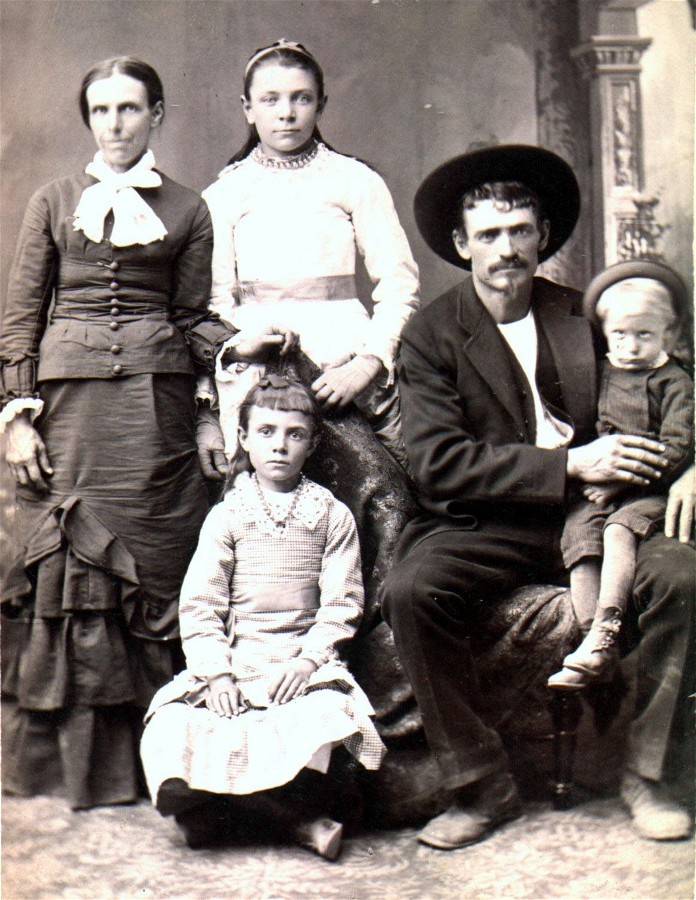
with children Nora (standing), Abbie & baby Walter
Lander, Wyoming, ca 1885
These notes were compiled from material gathered since 1979/1980 by personal research & correspondence. Other than my parents, grandparents, aunts/uncles & other individuals mentioned in the narrative, I am especially grateful to the following "cousins" whose records, photographs, stories & oral traditions, along with my own, helped us all gain a better understanding of our family heritage.
- - - - -
The late Georgia Hulett & daughter Jean Werts, Dubois, Wyo, descendants of Abigail "Abbie (Gaylor) Rhodes, youngest daughter of Jack & Sallie Gaylor
Linda French, Wagoner, OK, descendant of Jack Gaylor's brother "Tom" Gaylor who resided in "Indian Territory" (northeast Oklahoma)
Jim Odell, Mae Windrix & Linda Smith of OK, descendants of Jack Gaylor's half-brother Bob Brummett
The late Jeanne Atkinson, Chelan WA, descendant of Viola "Babe", youngest daughter of Ed & Nora (Gaylor) McKinney
The late Jim Phillips of Dallas TX, descendant of the Pendleton family
Rita Roose of Farmersville, TX, descendant of the Kilgore family
Raymond & Carolyn Simpson, descendant of William Rowland Simpson of middle TN, maternal uncle of Jack Gaylor
Gayle Wilcox & Mary Louise Bates, descendants of Roseanna (Simpson) Mitchell of Seligman, Barry County, MO, maternal aunt of Jack Gaylor
Ann Corum of Hazel Green, AL, descendant of Rev James Fletcher Gaylor of east Alabama, paternal uncle of Jack Gaylor
- - - - - - -
If these notes, excerpts or photos are copied, shared with others, published or displayed on the internet, it will be appreciated that proper genealogical etiquette be observed, acknowledging the compiler. Any "legitimate" additions or corrections, etc. will also be greatly appreciated.
**********************************************************************************************************************************************************
30 Jul 1867 - Collin Co TX (Voter Registration)
J.F. GAYLOR, Born TN (Left State)---probably A.J. GAYLOR
(transcription error).
W.G. PENDLETON (Jack's brother-in-law)

12 Sep 1867 - Collin Co TX (Marriage Record)
A.J. GAYLOR married SARAH E. PENDLETON. J.M. Benge, Court Clerk; E.L.
Augel, M.G.
**************
From "Collin County: Pioneering in North Texas", by Capt Roy F. Hall & Helen Gibbard
Hall are the following excerpts:
"There were few horses left in the county as the army had taken them all but there was a
surplus of bushwhackers. - - - The years immediately following the Civil War, or from
1865 to 1870 were perilous ones in this section of Texas. An influx of Carpetbaggers
overran the country, bringing not only the Carpetbaggers themselves, but also many
discharged Union soldiers, attracted at the prospect of taking over the land and property
of Ex-Confederates, as had been halfway promised them. - - - - - Unwilling to lose their
lands, the farmers, resorted to the guerilla tactics resorted to by the "bushwhackers"
during the war. This is, they took to the thickets and fought back, some even took to
banditry by preying on the Carpetbaggers, the JayHawkers from Kansas, and the
scallawags-the fellow who had hid out as a Union sympathizer during the war. In
Northeast Collin County, with Blue Ridge as about the center, this warfare reached its
peak in the Lee-Peacock feud, in which a good many men lost their lives.- - - - - -- - - - - -
Lewis Peacock was killed from ambush on June 14, 1871, and Bob Lee died the same way
on the morning of May 24, 1869. Both had been leaders in the feud, and both were good
men but with widely divergent views. - - - - - - - there was a lot of right and a lot of
wrong on both sides, but, as stated before, these were perilous times in Collin
County."
************** 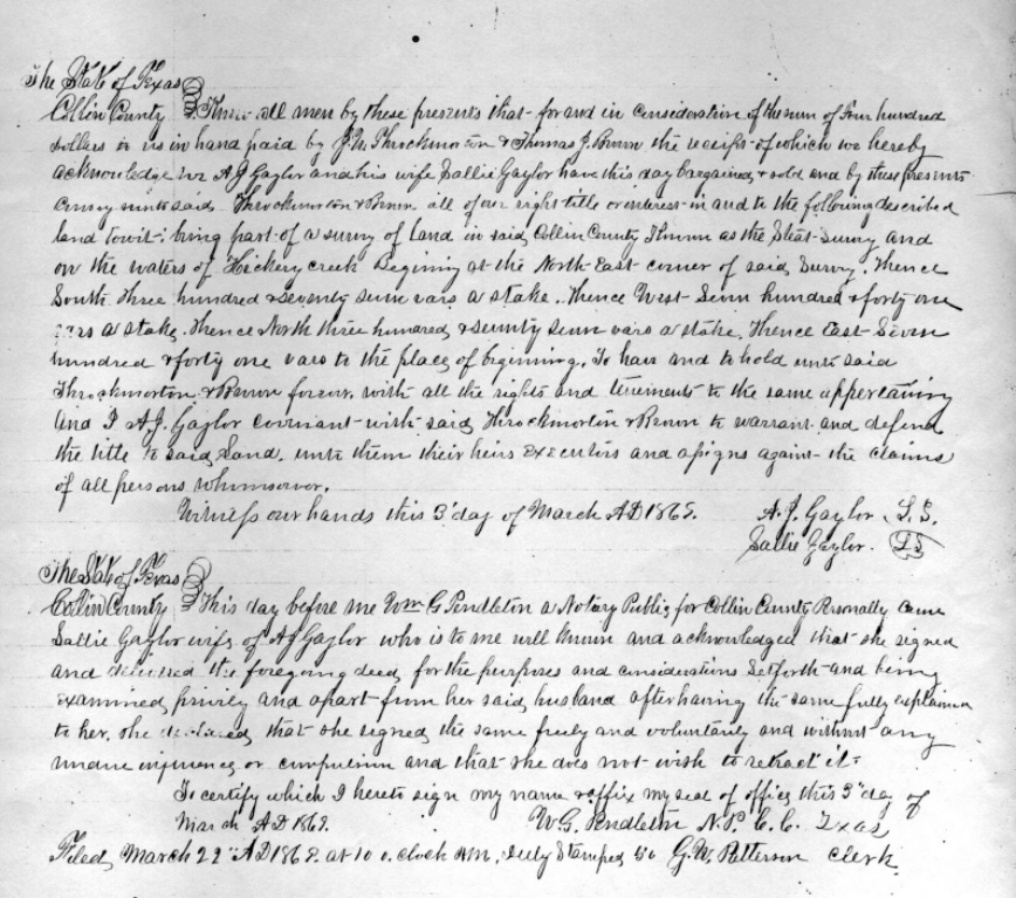
(TRANSCRIPTION): 3 Mar 1869 - Collin Co TX (Sale of Land-Vol R, Pg 346)
"The State of Texas - Collin County. Know all men by these presents that for and in
consideration of the sum of four hundred dollars to us in hand paid by J.W. Throckmorton
& Thomas J. Brown the receipt of which we hereby acknowledge A.J. Gaylor and his
wife Sallie Gaylor have this day bargained & sold and by these presents convey unto said
Throckmorton & Brown all of our right title or interest in and to the following described
land towit: being part of a survey of land in said Collin County known as the STAATS
SURVEY and on the waters of HICKORY CREEK beginning at the NORTH-EAST
corner of said Survey, Thence SOUTH three hundred & seventy seven varas a stake.
Thence WEST Seven hundred & forty one varas a stake. Thence NORTH three hundred
& seventy seven varas a stake. Thence EAST Seven hundred & forty one varas to the
place of beginning. To have and to hold unto said Throckmorton & Brown forever with
all the rights and tenements to the same appertaining and I A.J. GAYLOR convenant with
said Throckmorton & Brown to warrant and defend the title to said land unto them their
heirs Executors and assigns against the claims of all persons whomsoever. Witness our
hands this 3' day of March AD 1869. A.J. GAYLOR; SALLIE GAYLOR
**************************************************************************************
Jack & Sallie Gaylor had acquired about 49 acres on Hickory Creek, just north of the
Pendleton farm which was inherited by Sallie's brother John Craig Pendleton after their
father, Rev John Pendleton died in 1861.
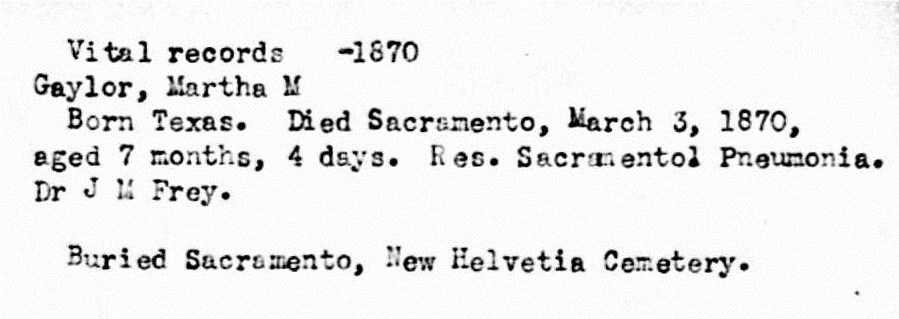
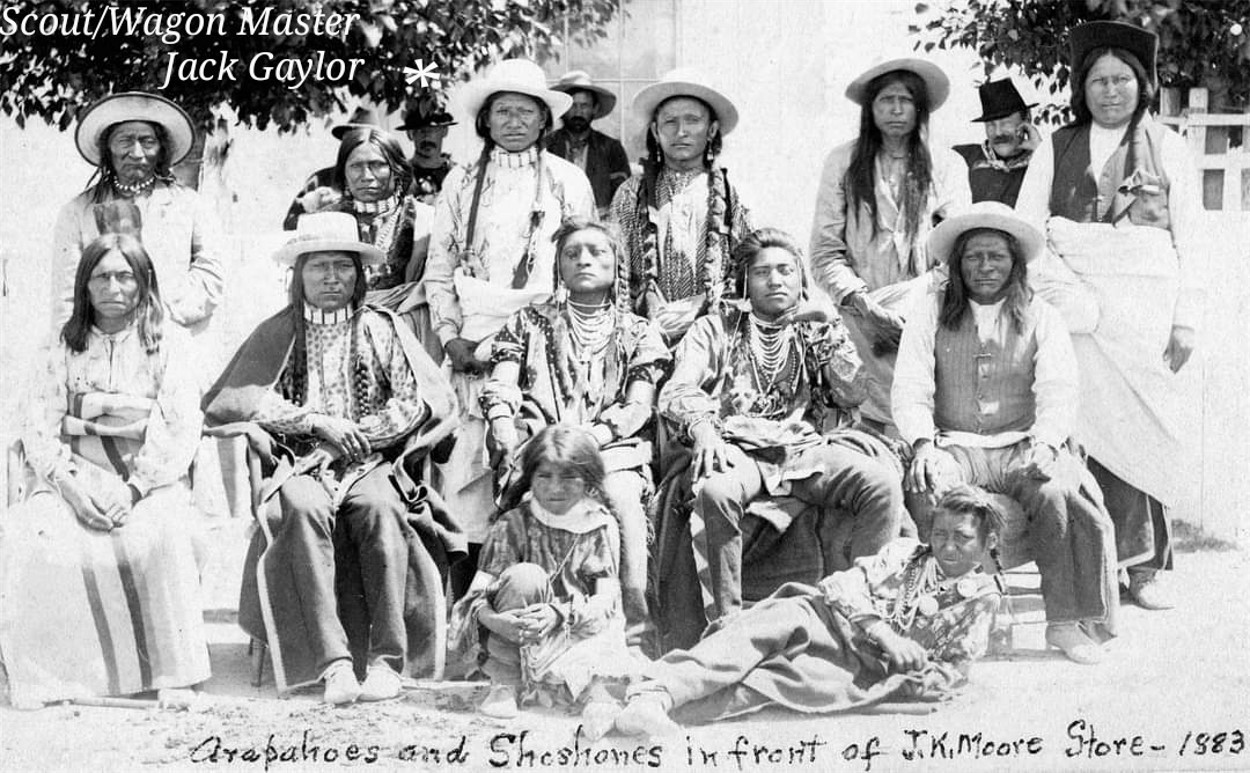
Andrew "Jack" Gaylor was a federal scout & packmaster "trail boss" with the cavalry at Fort Washakie during the early 1880's before establishing his homestead in Sinks Canyon. I believe Jack was the man who was seated in the back of an 1883 group.photo with 4 scouts/packmasters & 11 Arapaho & Shoshone chiefs at the J K Moore store at Fort Washakie.
Below is a closeup of the man seated in the back of the group photo. I believe he is the same man (above) with small hair growth under lower lip (mouche).
Below is Jack Gaylor, age mid 30s about 1885. Notice the jawline, cheekbones & full mustache with small hair growth under lower lip (mouche) that grew to a tiny goatee.


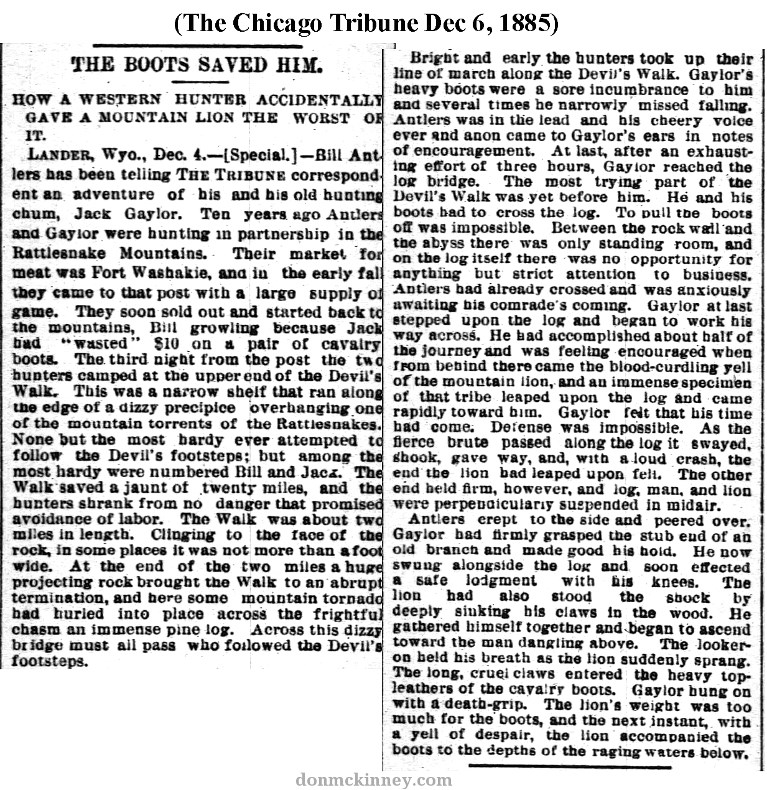
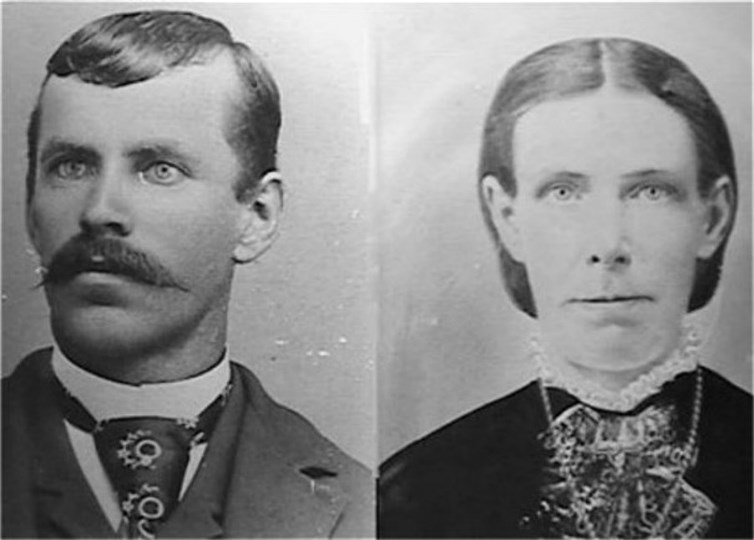
(Photos courtesy of Georgia Hulett & daughter Jean Werts, Dubois, Wyo, descendants of Jack & Sarah's daughter Abbie Gaylor Rhodes)
************************************************************************************************************************

************************************************************************************************************************
11Jun1885 - General Land Office,EvanstonWY(Homestead Application #188) ANDREW
J. GAYLOR settled on homestead in Sinks Canyon, Lander, Fremont Co WY (Homestead
Certificate #133, Final Grant 29 Feb 1892). He sold this land to H.G. Nickerson, 18 Jan
1895.
************************************************************************************************
September 17, 1887-"A.J.Gaylor will please accept the thanks of the CLIPPER force for two large delicious watermelons."
February 4, 1888-"A.J. Gaylor was in town Monday. Jack was in a very talkative mood and unbosomed himself of some cold facts which were not very well relished by some of his audience, while others applauded."
August 2, 1888-"A CHALLENGE TO SPELL-J.G. Borner and A.J. Gaylor, two of the patrons of Miss Alden's school, request us to say that they each have a pupil which they will match against any two of like age in Fremont County, for a spelling bee."

***************************************************************************************************************************
Barry, a niece of Mrs James Lynch, one of a fishing party to the Sinks in the Big Popoagie canyon last Tuesday, slipped from a rock into the stream and was drowned before help could reach her. Miss Barry came to Lander some weeks since, intending to spend the summer and perhaps a longer time with her aunt. She had been looking forward with a great deal of pleasant anticipation to the trip to the Sinks and when the party was made up, consisting of Mr and Mrs Lynch, Hattie Baldwin, Mamie McCoy and herself, some entered into the project with more spirit. The most of the day up to five o'clock was spent in fishing and picnicing; at that time the party became somewhat divided, Mr Lynch going to get the team in preparation to coming home, and leaving Miss Barry and Miss McCoy fishing from a large rock a short distance above Jack Gaylor's house. Miss McCoy thinks that while Miss Barry was stepping around her on the rock she must have slipped off backwards, as when she first saw her in the water, she was lying on her back and the water was carrying her down. She at once ran for the rest of the party, some of whom stared for assistance to Gaylor's house while Mr Lynch followed down the stream. He found the body about 200 yards down, just opposite the house, and with the assistance of Mr Gaylor it was gotten out. At this time it was evident that life was extinct; there were numerous bruises on the face and body, and it is not unlikely that being dashed against the rocks by the swift current would have been sufficient of itself to cause her death. The rocks and current at this part of the stream are as bad as at any place in the river, and a strong man would have difficulty in
holding his own were he to slip in. The body, as it was taken out on the side across from Gaylor's house, and the stream at that point could not be forded, had to be taken up that side to the bridge in the canyon, and was there laid in Mr Lynch's buggy and brought home. The funeral services were largely attended yesterday morning, Rev Father Ponsigtione officiating, the interment being made in the Odd Fellows cemetery. The regret for the sad affair is universal, and deep sympathy is expressed for the friends.
This is a "grainy" photo showing how the house looked soon after Jack sold it to Nickerson. I used photo software to add Jack Gaylor standing in front of the entrance that was facing east. I also added the rifle. Sinks Canyon road is behind the house.
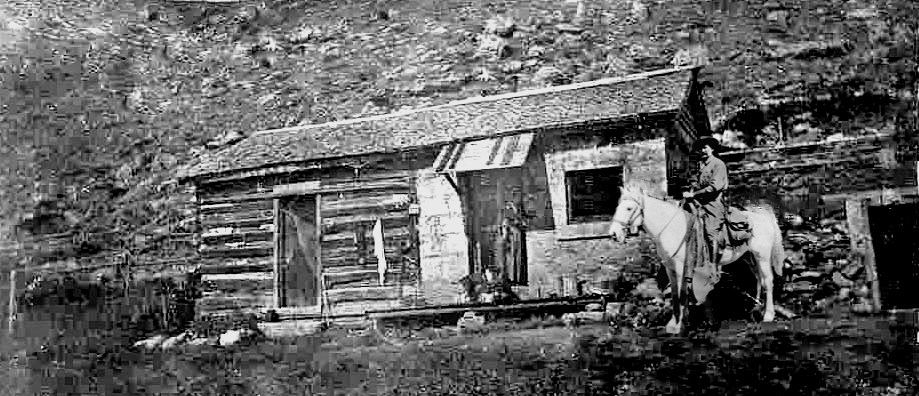
(Photo courtesy of Jack States, descendant of the States family. As the house looked a few years after Gaylor sold it. I used photo software to add Jack Gaylor mounted on a white horse. Per requirements of the homestead, Jack built a log dwelling where he & his family resided. After his wife Sarah died in December 1886, Jack remodeled the log house when neighbor Jacob Frey added a stone room.
H.G. Nickerson purchased the 160 acre homestead from Jack in 1895 and it was later sold to JM Vidal and Eugene Amoretti Jr. in 1899.
It was known as the "States Place" for several decades after Minnie States & her son Herbert States purchased it in 1903. )

*****************************************************************************************************

******************************************************************************************************

(From the Newspapers web site, I recently found an old newspaper article from the "San Francisco Examiner" dated February 1895 that published an article about Jack Gaylor & his "Indian" exploits in Wyoming. This was a month after he sold his sinks canyon homestead in January 1895. The 16 year old "niece" mentioned in the SF article as being escorted there by uncle Jack to attend school, is believed to have been his sister Sarah Matilda Uhls' 19 year old daughter Emma Uhls from Muskogee, Indian Territory who was visiting her Gaylor relatives in Wyoming Oct/Nov 1894. She returned to Muskogee by 1896). There were errors in this article including when Jack arrived in Lander, Wyoming. He did not arrive 29 years prior to the article (1866). He arrived in Cheyenne in 1875 & in the Lander area, Fort Washakie, South Pass about 1880.

Andrew "Jack" Gaylor, chief packmaster with 7th Cavalry, Huntsville, Alabama, 1898
(Photo courtesy of Georgia Hulett & daughter Jean Werts, Dubois, Wyo, descendants of Jack & Sarah's daughter Abbie Gaylor Rhodes)

(Andrew "Jack" Gaylor as civilian packmaster with 7th Cavalry at Camp Force near Huntsville, Alabama, winter 1898--- in December 1898, they moved on to Macon, Georgia before deploying to Pinar del Rio, Cuba in January 1899. He left Wyoming for Florida with "Torrey's Rough Riders" (2d US Volunteer Cavalry), but because of Col Torrey's injuries in a train accident & other issues, that outfit was mustered out & Jack was transferred to the 7th Cavalry.)
Excerpt printed in above newspaper from a long letter sent by Jack Gaylor to the editor
from Florida. "FROM THE ROUGH RIDERS - Camp Cuba Libre, Jacksonville, FL, Jul
18, 1898. Dear Sir: As I am way down here in Florida, I would like to have the news, so
I will enclose $1 to you, for which you will please send me the Clipper. I am one of the
boss packers for the Rough Riders. We may stay here for some time as Col Torrey is still
unable to walk. - - - - - - We had a bad smashup on our way down here & several of our
boys were killed - - - - -- - - Well, anyway I did not get killed and I am still in the ring, and
I am going to have a mule load of Spaniards' ears before I come back. - - - - - - -We take
the long eared mules, with packs, out and drill every day. We expect to pack all of the
grub and ammunition for our regiment. We will stay until the Spanish lads are conquered.
- - - - - Yours truly, A.J. GAYLOR"
Excerpt from a Macon, GA newspaper item sent by Jack Gaylor to the editor from
Macon, GA:
"A PRETTY WEDDING IN SOUTH MACON, GEORGIA - We clip the following from
a Macon, GA paper of January 12, which will be of great interest to many of the people of
this section of the country. (Editor of Clipper)
A marriage occurred in South Macon last night with just a tinge of romance about it.
The contracting parties were Miss Lizzie Shinolser to Mr A.J. Gaylor, chief packmaster of
pack train No. 27, which is attached to the Seventh Cavalry in camp here. The groom is a
native of Lander, Wyoming. He came to Macon with the Seventh Cavalry and shortly
after arriving here met the young lady who subsequently consented to be his bride. Mr
Gaylor has spent most of his life on the plains and as he stated last night, felt more at ease
in a buckskin suit on the alkali plains of Wyoming than he did in a dress suit. - - - - -"

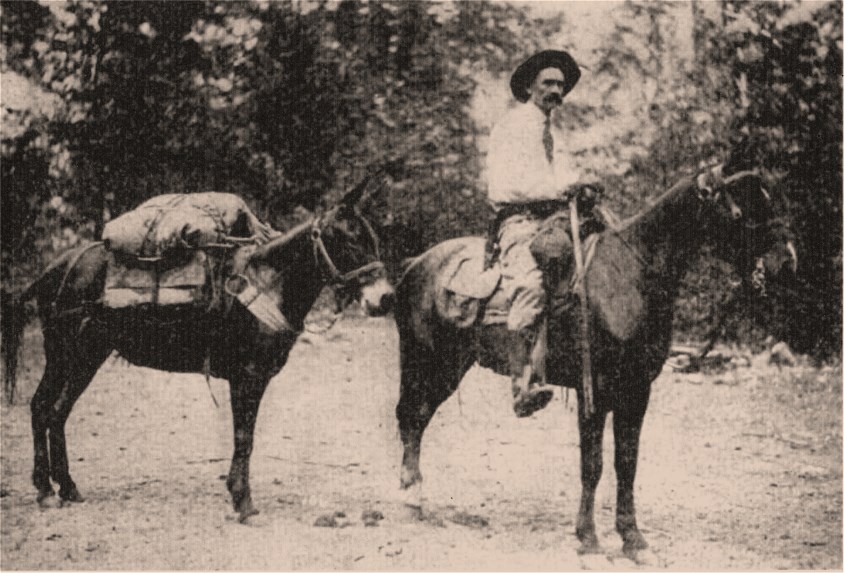
Assistant Chief Park Ranger Andrew "Jack Gaylor. Yosemite National Park
(Grainy photo from Sunset Magazine, The Pacific Monthly 1919)
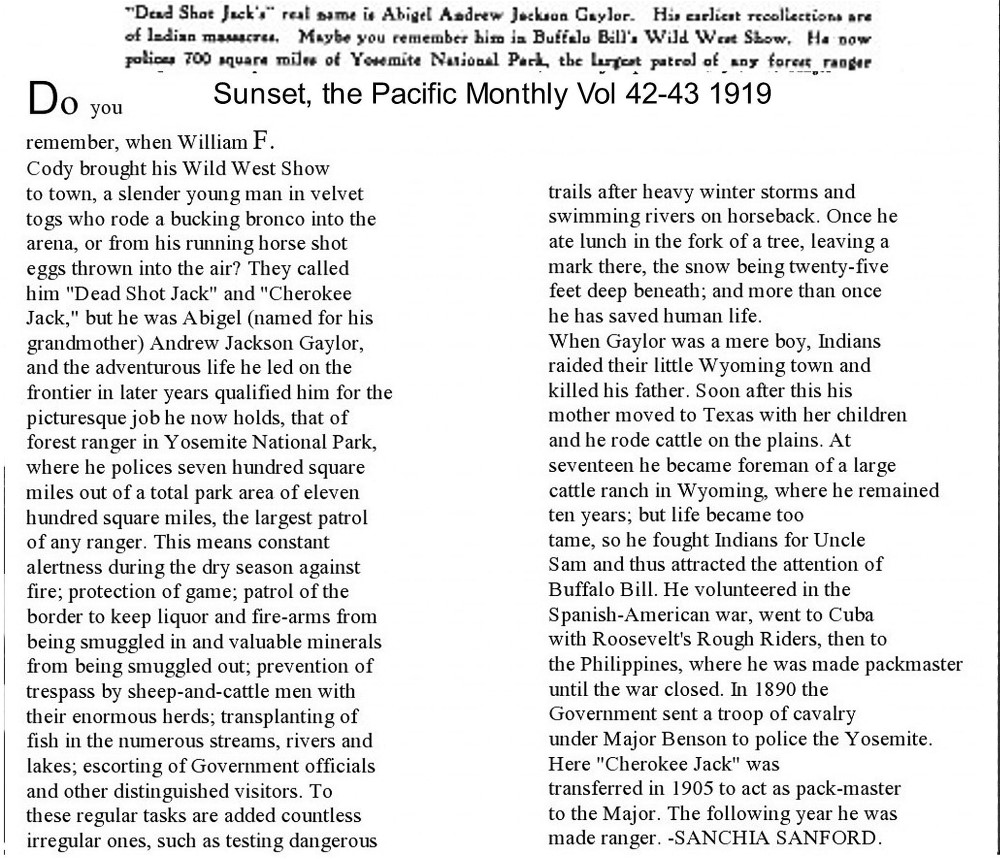
MY CORRECTIONS CONCERNING THE 1919 ARTICLE BY SANCHIA SANCHEZ.
1. I never found evidence that ancestor Jack Gaylor was ever associated with Buffalo Bill, either as a trick shooter in his early "wild west shows" or in combat with Cody during the Sioux Wars in Wyoming during the 1870's. He did, however, serve as a scout, stagecoach driver & freighter during the mid 1870's throughout Wyoming & Dakotas as well as a Federal scout/ wagon master at Fort Washakie, Wyoming during early 1880's.
2. Jack's full name was Andrew J. Gaylor. His name was NOT "Abigel" & he was NOT named after a grandmother. His middle name is believed to be Jackson with the nickname. "Jack". He had a daughter named Abigail. However, I found a census record that had his name as "A. Andrew J. Gaylor".
3. His father was NOT killed by Indians in a small town in Wyoming, but died in Tennessee or Missouri when Jack was a child.
4. Jack was NOT in Wyoming as a child, but came with his mother to Texas from Tennessee & Missouri, but, he it is believed he was a scout & helped drive cattle on the plains in Texas & Indian Territory with younger brother Tom in their youth.
5. Jack & wife Sallie left Texas in 1869 & settled in Placerville, California where he mined for gold. He returned the next year to the Cherokee Nation of Indian Territory the next year where his mother & siblings resided.
6. Jack & family arrived in Cheyenne, Wyoming about 1875 after he left Indian Territory & Arkansas.
7. Jack was a foreman of the large Durbin brothers cattle ranch near Cheyenne, when he was in his late 20s or about 30, NOT 17, and only for a brief time, NOT 10 years. He drove a stagecoach to Deadwood & freighted in that area.
8. Jack sold his homestead near Lander, Wyoming & joined "Torrey's Rough Riders" in 1898 as a civilian packmaster---NOT "Roosevelt's Rough Riders".
9. Jack was appointed Park Ranger at Yosemite in 1907 & died in 1921 of heart failure while on a high mountain patrol.
(He died about 2 years after the article by Sanchia Sanchez was published.)
"My training and experience has led up to a Rangers duty since the Spanish War began in
1898, when I left Wyoming with Colonel Tory's rough riders as packmaster to
Jacksonville, Fla. From there I was transferred to the 7th Cavalry at Huntsville, Ala.
From there ordered to Cuba with the 7th Cavalry. I had a great deal of experience in
teaching the civilian packers & soldiers to pack with the diamond hitch, which the Gov.
requires all packers & rangers to use.
From Cuba I was transfered to Manila P.I. & was promoted to Chief Packmaster &
was with General Funston doing his packing & packed any and everything from a cannon
on down. From Manila P.I. I was ordered back to the U.S. and was with packtrain at
Presidio S.F. - - - - - - -In the spring of 1907 was telegraphed and asked to come to S.F.
and take charge of packtrain for Yosemite National Park service which I did. Remained
with it packing supplies for Soldiers during the summer & helped them to fight forest fires
also packing and helping Major Benson plant fish until Sept 9th 1907 at said date I
received my appointment for Rangers duty in Yosemite National Park from the Dept of
the Interior, and have remained with it ever since. - - - - (Andrew J. Gaylor, Asst Chief
Park Ranger)
Excerpt from article: John Muir Centennial 1838-1938
“-----President Theodore Roosevelt sought peace and quiet with Muir on a camping trip to Yosemite in 1903. With only two early day rangers, Jack Gaylor and Charles Leidig, as guides, the two great naturalists camped one night under the great Sequoias of the Maripose Grove, then by horseback they rode to Sentinel Dome for another night under the stars. On the third day the group rode into Yosemite Valley via Glacier Point and the 11-mile trail. An elaborate banquet had been prepared for the President at the Sentinel Hotel, and many prominent political personages were there to greet him.-----”
***********************
WAR DEPARTMENT (Civilian Personnel Records Center, St Louis)
1Jul1880-1Jul1882 (Packmaster & scout at Fort Washakie, Wyo)
10May1898-1898(Packmaster Torrey's "Rough Riders"(2d
USVol)Cheyenne/JacksonvilleFL)
1898-1Jun1900 (Packmaster with 7th Cav Huntsville, AL/Macon, GA/Pinar del Rio
Cuba/Manila,Philippines)
1Jun1900-1Jan1901 (Chief Packmaster with Gen Funston's Command at San Isidro,
Luzon,Philippines)
1Jan1901-10Sep1907 (Packmaster w/pack trains Presidio of SF/Camp Yosemite)
DEPARTMENT OF INTERIOR (Civilian Personnel Records Center, St Louis)
10Sep1907-19Apr1921 (Park Ranger/Asst Ch Park Ranger Yosemite Nat Park CA)
**********************
16 Aug 1910 - Mariposa County, CA (Voting Precinct Register)
"Yosemite Precinct
No.23 ANDREW J. GAYLOR/Age50/Occupation-Ranger/Address-Yosemite/Party
Affiliation-Democrat" (Note: Jack fibbed about his age again. He was actually 64)
**********************
1911 - Yosemite National Park (From the Merced Sun Star, dated 1 Mar 1986, Merced,
CA) by Leona Lewis, Editor of Living Section
Excerpts:Horses hit by lightning in 1911 during a thunderstorm near Glacier Point in
Yosemite Valley were ordered burned on the spot by the one and only ranger on duty. - - -
- - - - In 1911 a party of 10 women and 8 men felt the wrath of Mother Nature in
Yosemite and lived to tell the story. The party of 18 sightseers traveled to Yosemite on
horseback at a time before blacktop covered its roads and trails.- - - - - -On July 21, 1911,
the caravan left the floor of Yosemite Valley - - - - -Just after they crossed Illilouette
Creek, they rode by 370 foot Illilouette Falls, and were winding up the hill on a zig-zag
trail when they came to a clump of tall pines. - - - - - -A bolt of lightning struck a nearby
tree, then went down the trunk to the ground. This bolt either jumped across or passed
along the ground. Anyway, it struck 10 mounted animals, killing seven horses and two
mules. The riders were not hurt. - - - - the riders were insulated by their leather saddles. -
- - -the lightning blew all the shoes off the horses - - - -According to reports, seven horses
fell with their hooves and legs pointing to the center of a half circle. - - - - - -their jaws
were cracked. - - - - --In 1911 there was only one ranger in Yosemite, JACK GAYLER.
Staying with the party for 2 and a half days, he made them pile logs on the horses and burn
all of them. Four five-gallon cans of kerosene were used to burn the horses - - - - -"
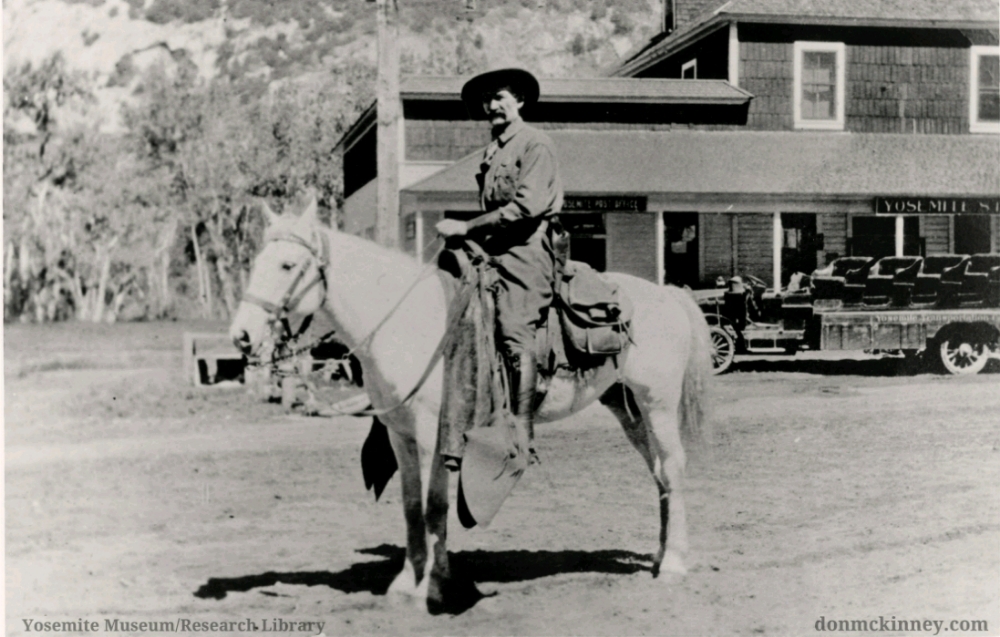
Andrew "Jack" Gaylor, Assistant Chief Park Ranger, Yosemite National Park, about 1915
(Photo from Yosemite Museum/Research Library, Yosemite National Park)
Chapter Seven: Changing of the Guard
"Although painful, the method outlined by Major Forsyth at least avoided killing the bears outright. But again the enormity of his request was swallowed by emotion. As long as people considered bears a threat to life and limb, any sign of an animal's real or imagined aggressiveness was bound to occasion a deadly response. Just two years later, for example, Forsyth presented evidence suggesting that his program failed to distinguish between bears acting aggressively and those reacting in self-defense. Ranger Gaylar, assigned to pepper the animals with buckshot, reported that he had killed "perhaps eight or ten bears" in his own self-defense. Under the circumstances, of course, it would have been impossible to determine whether the bears really meant anyone any harm or had simply lashed out at Gaylar's own aggressiveness.----Undoubtedly Ranger Gaylar had overreacted; his response was nonetheless in keeping with current perceptions. Opinions about wildlife were still largely influenced by frontier myths and emotions.
“In a 1948 interview, feisty Elizabeth Meyer, owner of Big Meadow, a cattle ranch 11 miles west of the Valley, supplied a sidelight: “When the military came in, it was “no cats” and all of us had to get rid of them. Then it was “no dogs”. I used to have to put my cats under me in the seat of the buggy so they wouldn’t take them out. Jack Gaylor would come out….he dyed his handlebar mustache black…reminded me of Simon Legree…“You can’t have but one dog” , he would say. But I would pacify him.”
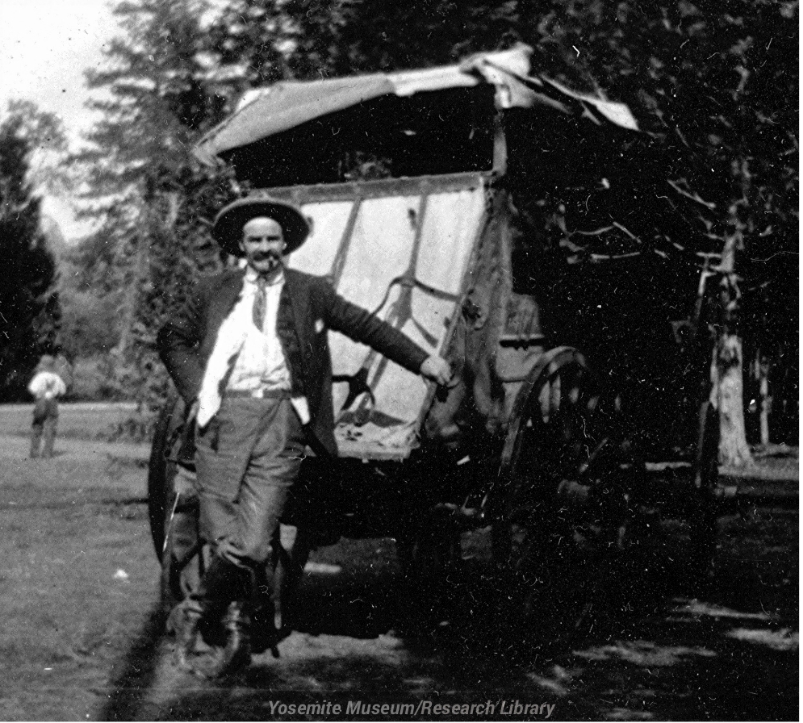
Andrew "Jack" Gaylor, Assistant Chief Park Ranger, Yosemite National Park, about 1919
(Photo from Yosemite Museum/Research Library, Yosemite National Park)
Excerpts: "- - - - -The two articles by your cousin Don were very enjoyable and by
chance, I ran into a fellow up here who knows more stories about Jack Gaylor. He is
Jerry Mernin, the district park ranger located at the south entrance. Seems he grew up in
YOSEMITE NP where his dad was a ranger, and Jack Gaylor was his idol from the
stories about him. A mutual friend had a Winchester of Jack's that Jerry coveted, but was
never able to obtain as it was given to the park (at Yosemite). Jerry mentioned one story
about Jack ordering a car to stop at one of the gates, and when they didn't, he leaped on
his horse and upon catching up, shot the tires out on one side. Then to be sure, he rode
around the other side and shot out the tires there.- - - - - -"
****************
***********************
19 Apr 1921 - Yosemite, Mariposa County CA (Death Record)
ANDREW J. GAYLOR, Born Jan 7, 1854 in Texas, 67 years, 3 months, 12 days
Asst Ch Park Ranger, Yosemite National Park; Wife: Elizabeth;
Father: JOHN GAYLOR; Mother: MARTHA SIMPSON
Sudden death without physician. Coronary Embolism. Frederick L. Stein, M.D.
Buried Merced, CA Apr 22, 1921 by Welch & Co Undertakers.
(Don's Note: Jack fibbed about his age through the years, probably to gain employment
with the Government. His age in official records ranges from 1846-1860. He claimed to
be born in Fannin Co, TX, but was actually born in TN.)
"ASST CHIEF RANGER DIES IN YOSEMITE NATIONAL PARK - A.J. Gaylor,
assistant chief ranger in Yosemite National Park, died suddenly at Merced Lakes Tuesday,
April 19. The body will be brought to Merced for burial Thursday, April 21, and will be
accompanied by Mrs Gaylor who was in Yosemite at the time of his death. The time for
the funeral will not be fixed until the arrival of the body in Merced and will be under the
auspices of Yosemite Lodge No. 30, Knights of Pythias, Mr Gaylor having been a member
of Phoenix Lodge No. 4 of San Francisco."
22 Apr 1921 - Merced Morning Sun, Merced, CA (Funeral Notice)
"GAYLOR FUNERAL TO BE HELD HERE AT 10 A.M. TODAY - Funeral services
for A.J. Gaylor, assistant chief ranger in the Yosemite National Park, who died
Wednesday at Merced Lakes, will be held here this morning at 10 o'clock at the Chapel of
Welch & Griffin, Eighteenth street at M. The services will be in charge of Yosemite
Parlor, Knights of Pythias. Mr Gaylor was a member of Phoenix Lodge, San Francisco.
Interment will be in Knights of Pythias cemetery."


Brief Excerpt: - - - - - "Jack as I remember was a tall, handsome man, and when you met
him, especially while he was on patrol in the saddle, he was man you never forgot, he was
that "outstanding". He looked you straight in the eyes and you never forgot just what he
was thinking. - - - - He was all for his love of the trails and mountains, always riding the
trails, and was on all trails of Yosemite National Park. He was a sight to see - - - - "

Assistant Chief Park Ranger Andrew "Jack" Gaylor, Yosemite National Park
(Photo purchased on Ebay & on the back was written "Dead Shot Jack" Gaylor, 1921)
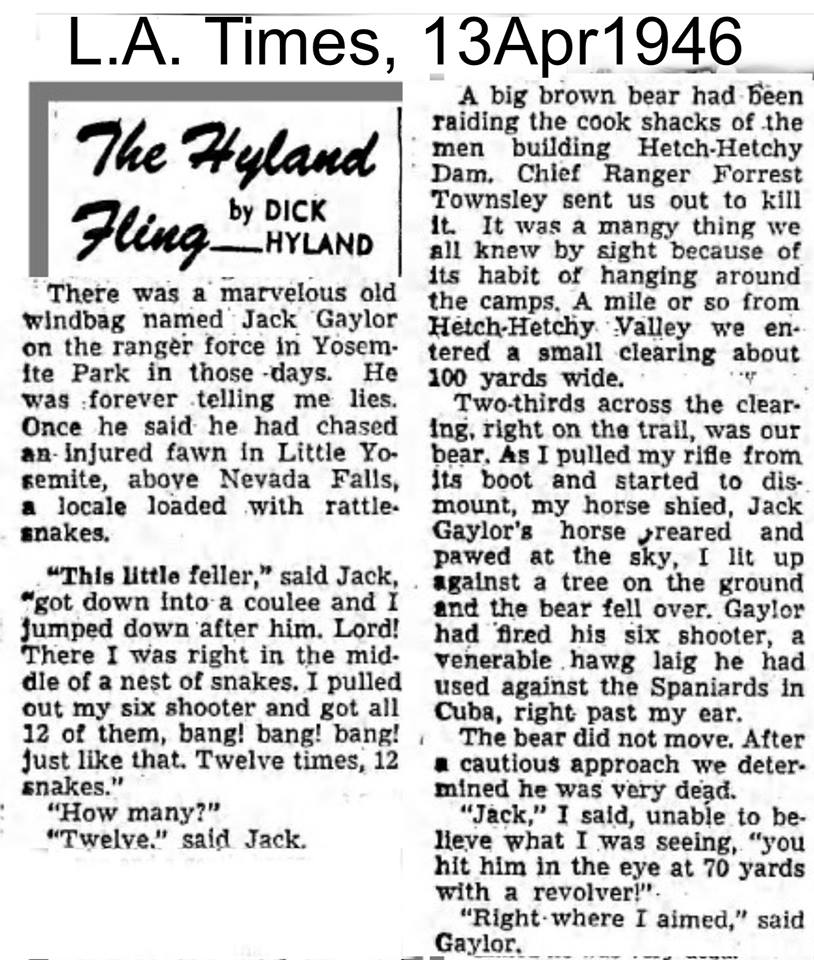

Assistant Chief Park Ranger Andrew "Jack" Gaylor (3d from the left)
(Photo from Yosemite Museum/Research Library, Yosemite National Park)
******************************************************************
Family Traditions: Myth or Reality
***************
Children of Jack & Sarah Gaylor:
Born: 27 July 1869 Farmersville (Collin) Texas
Died: 3 March 1870 Sacramento, California
Born: 19 May 1871 Cherokee Nation, Indian Territory
Married: EDWARD COFFIN McKINNEY 27 Mar 1893 Lander(Fremont) Wyo
Died: 3 Feb 1947 Escondido, CA
Buried: Borners Garden, Lander, Wyo
Born: 2 Jun 1875 Ind Terr/Ark
Married: CHARLES WALDON RHODES 6 Oct 1893 Lander(Fremont) Wyo
Died: 14 Oct 1964 Evanston(Unita) Wyo
Born: 1879 Cheyenne(Laramie) Wyo
Died: 1880 Cheyenne(Laramie) Wyo
Born: 12 Jan 1881 Lander(Fremont)Wyo
Married: LILLIAN (Divorced)
Died: 27 Oct 1936 Pasadena, CA
Buried: Borners Garden, Lander, Wyo
THIS PAGE & MY ENTIRE FAMILY HISTORY DOMAIN IS PROTECTED BY AWARD WINNING "SITELOCK SECURE".
I PAY A MONTHLY FEE FOR THIS PROTECTION vs A SSL CERTIFICATE.
